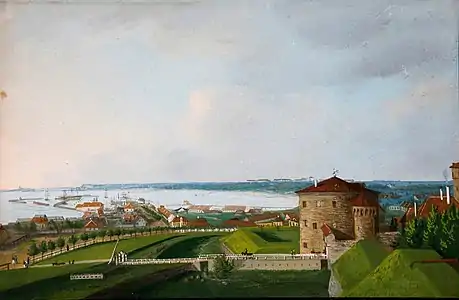Johannes Hau
Johannes Hau (17 April 1771, Flensburg - 3 August 1838, Reval) was a Baltic-German landscape painter.

Life and work
His father, Jens Petersen Hau, was a ship's captain. In 1795, he left his hometown and moved to Tallinn (Reval, in German). There, he became a master painter and by 1806, he was serving as an Ältermann (a type of administrative official) with the Canute Guild. From 1818 until his death, he was the guild's chairman.
He is best remembered for his small-scale vedute of Reval and Narva done in gouache. These were very popular with upper-class people from St. Petersburg, who came to visit the city's spas.[1] In 1823, he organized an exhibition at his home, which was one of the first solo exhibitions of any type held in Reval.[2]
He was interred at the Kopli cemetery, which was destroyed in the 1940s, during the second Soviet occupation of the Baltic states.
His two sons, Eduard and Woldemar Hau, also became well known painters.
Views of Reval (Tallinn)
 Russian Coast Artillery in the Harbor
Russian Coast Artillery in the Harbor View of Reval from the Northeast
View of Reval from the Northeast View of the Great Coastal Gate
View of the Great Coastal Gate
References
External links
- Baltische Historische Kommission, entry for Johannes Hau. In: Baltisches Biografisches Lexikon Digital
- More works by Johannes Hau at the Art Museum of Estonia, Digital Collection